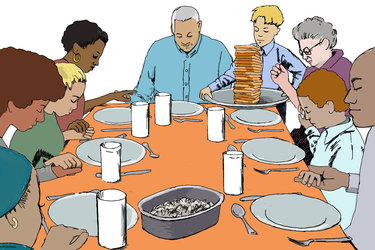Cuts that undermine our freedom from want are already underway
With the shutdown of the federal government, much focus has been placed on feeding people — one in eight Americans — who relied on the Supplemental Nutrition Assistance Program.
We commend the many local efforts to stock food pantries and help neighbors in need. But, as we wrote on this page last week, it is the duty of our nation’s government to meet these needs for the good of our society as a whole.
This week, we are looking at the changes to SNAP coming from the so-called “One Big Beautiful Bill” budget reconciliation, some of which are already in effect.
The bill is beautiful only for those who are already well off and will get wealthier because of it. Meanwhile, it will add over $3 trillion to our national debt, according to an analysis by the nonpartisan Congressional Budget Office.
But SNAP recipients, even if the current crisis has been resolved, will continue to lose ground as the gap in our country between the haves and the have-nots continues to widen.
First, certain utility and housing costs can no longer be used in calculating eligibility for SNAP benefits. New Yorkers who use the Low Income Home Energy Assistance Programs used to be able to deduct a set allowance to qualify for SNAP.
Over 2.2 million New Yorkers received LIHEAP benefits in 2023, a year when 31 percent of adults forwent necessary expenses, such as medicine or food, to pay an energy bill and when 22 percent kept their home at an unsafe or unhealthy temperature due to rising energy costs.
Also, internet bills can now no longer be factored into calculations when applying for SNAP benefits. This may force some households to do without the internet, which is particularly dire for families with children.
“We find that students who do not have access to the Internet from home or are dependent on a cell phone alone for access perform lower on a range of metrics, including digital skills, homework completion, and grade point average,” concludes a study conducted in Michigan during the pandemic. “They are also less likely to intend on completing a college or university degree.”
This will widen that gap between the rich and the poor for future generations.
Second, work requirements have also been changed. Previously, able-bodied SNAP recipients without dependents had to meet certain work and training requirements up to age 54; that has now been extended to age 64.
Households with dependent children had been exempt from additional work requirements if their children were 17 or younger. That has been lowered to age 13.
The Economic Policy Institute, a not-for-profit, nonpartisan think tank funded by foundation grants and labor unions, published a paper earlier this year that found, “More stringent work requirements in the past have failed to boost work in significant ways because they don’t attack the core problems of weak economic conditions or the irregular and unpredictable scheduling practices of low-wage jobs. Instead, requirements increase administrative burdens for adults seeking needed benefits.”
Those who are ratcheting up work requirements, the paper says, “are clearly trying to exploit a vague, but pervasive, sense that some recipients of public support are gaming the system to get benefits that they do not need, as they could be earning money in the labor market to support themselves instead.”
“That myth of rampant fraud is a false narrative that needs to stop now,” Natasha Pernicka, who directs the Food Pantries of Capital District, said at a press conference last week. “These are millions of people's lives. In fact, the majority of people who receive SNAP assistance are children, older adults, and people with disabilities. These are our most vulnerable community members.”
The Economic Policy Institute paper states that “almost none of the alleged benefits of ratcheting up work requirements are economically significant, but that the potential costs of doing this could be large and fall on the most economically vulnerable.”
The paper goes on to note that in-kind benefits like SNAP and Medicaid “are not generous enough to support a decent standard of living, and they provide no help with other expenses families have. In short, the incentive for adults to secure steady work at decent pay remains utterly enormous: It is the difference between living in profound material hardship versus having a more comfortable existence.”
A report from the Center on Budget and Policy Priorities, a progressive not-for-profit American think tank, published in April, said, “Adults who receive SNAP often work in occupations and industries with low pay or unstable hours that cause income volatility, such as important frontline service or sales roles like cashiers, cooks, or home health aides. Many of these jobs often lack benefits such as paid family leave — or even paid sick days — which means that a worker’s own illness or an illness in the family can lead to job loss.”
The center wrote of a work-reporting requirement, “Numerous studies have shown that this harsh policy does not increase employment or earnings — it just cuts people off from the food assistance they need to buy groceries.”
Third, the United States Department of Agriculture, which administers the SNAP program, will no longer use the Thrifty Food Plan benchmark, typically adjusted yearly for inflation and recalculated every five years based on the price of foods, dietary guidelines, and eating patterns.
In 2021, in the midst of the pandemic, the TFP benchmark went up 20 percent, so SNAP recipients got $12 to $16 more per month, “preventing disparities in food insecurity and health outcomes,” a study from Harvard and Johns Hopkins researchers showed.
Starting on Oct. 1, 2027, adjustments will be based only on inflation. After that, if the price of food increases for any reason but inflation — like egg prices soaring because of bird flu — the benchmark will not change.
Fourth, states will have to bear more of the burden of the once-federal food-stamp program. The USDA currently splits SNAP administrative costs evenly with the states.
Starting on Oct. 1, 2026, the USDA will pay only a quarter of the costs, leaving three-quarters for the states. States that can’t afford the extra costs may be forced to reduce their SNAP funding accordingly.
Fifth, SNAP-Ed has been eliminated; it lost funding at the end of September.
The educational program taught SNAP recipients how to best shop for and prepare nutritious meals with “thrifty meal planning and food-dollar budgeting skills … incorporated into each SNAP-Ed lesson.”
A one-year study of Indiana households with children found that food security improved by 25 percent when a household adult received a SNAP-Ed intervention compared with a control group.
“The impact of SNAP-Ed to sustain improvement in food security among the entire household and for household adults is remarkable considering that only 1 person from each household received the intervention,” the study said.
We are reminded of the proverb, “Give a man a fish and you feed him for a day; teach a man to fish and you feed him for a lifetime.”
The short-sightedness of cutting SNAP-Ed is emblematic of the larger problem.
Our current lawmakers are missing the point: SNAP benefits everyone, not just the direct recipients.
Cutting back on SNAP benefits is not money that is saved. SNAP money is immediately turned back around and spent; it is well known as an economic stimulus.
Food stamps started in the depths of the Great Depression. Farmers had unmarketable food surpluses while widespread unemployment caused many to go hungry.
Milo Perkins, the program’s first administrator, said, “We got a picture of a gorge with farm surpluses on one cliff and under-nourished city folks with outstretched hands on the other. We set out to find a way to build a bridge across that chasm.”
The quickest way for the federal government to put money in a lagging economy is through the food stamp program; more than a dollar is generated for every dollar that goes to a SNAP recipient.
In a ripple effect, the money spent on food pays the farmer that raises the food, pays those that haul the food to market, and pays those that sell the food.
Besides the economic ripple effect, there is also what we call the full-belly effect. Put simply: A person, particularly a child, is not productive or able to learn well and succeed in life if she or he is hungry.
People who are well fed are more likely to rise from poverty.
We live in a land of plenty but one in eight Americans are hungry. We must bridge the chasm, not widen it.


